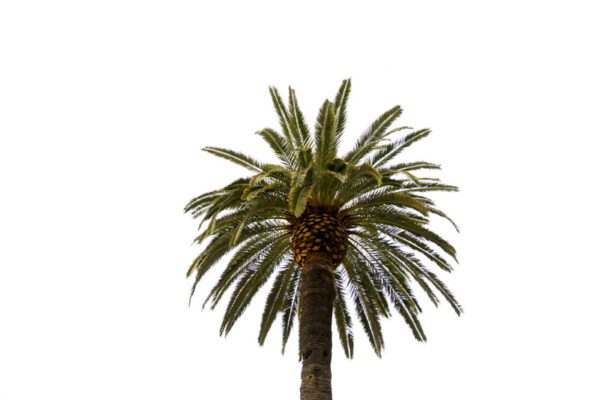If you’ve lived in a place long enough to see the trees grow up with you, then you understand how heartbreaking it is to watch them die. Here in San Diego, our Canary Island Date Palms, with their massive trunks and feathery crowns, have long stood as markers of elegance and age. They define so many of our streets, from the historic grandeur of Balboa Park to the stately rows lining drives in Rancho Santa Fe and La Jolla. But in the past several years, something has changed. These iconic giant palms are struggling. Some decline slowly, almost imperceptibly at first, while others collapse almost overnight.
As a company that works with trees every day, we can’t tell you how many times we have received the same question again and again: “Why is this happening?” It’s a sorrowing sight to drive past a once-majestic palm now looking shriveled and dried up. It feels like a piece of our landscape is vanishing.
Let’s walk through it. What is hurting these palms? What should you be looking for? And what can you do about it? It’s not a simple answer, but understanding the threats is the first step toward protecting these beautiful palms.
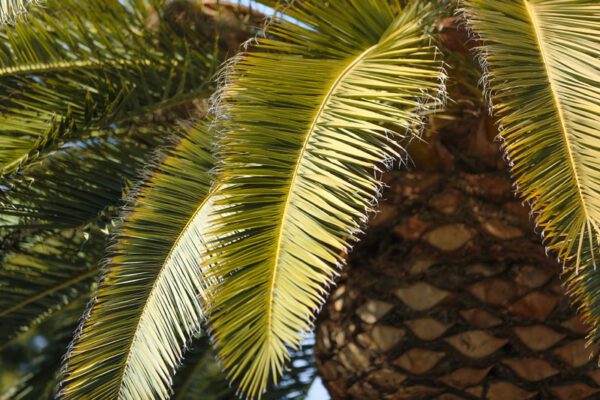
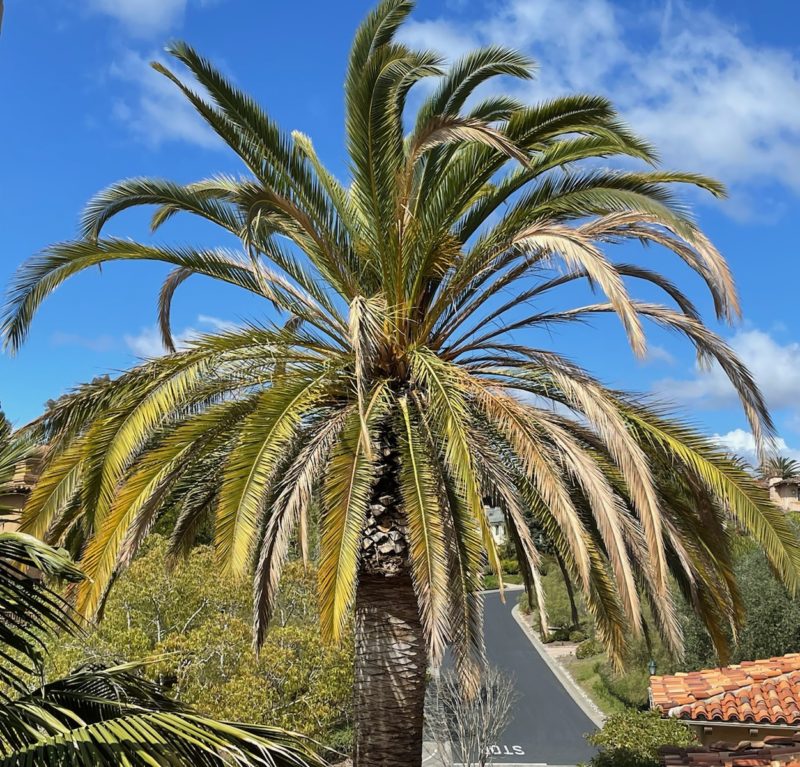
What are the three main threats to the Canary Island date palm?
There are three major reasons Canary Island Date Palms are dying throughout San Diego and Southern California. We’re talking about Fusarium wilt, the insidious fungal disease, the rapidly destructive South American Palm Weevil, and unfortunately, poor maintenance. Each one alone is a problem, but combined, they are a serious threat to the long-term survival of these iconic trees across our region
1.
Fusarium Wilt
The slow drain
When it comes to diseases, Fusarium wilt is probably the most frustrating because there is no good cure once it takes hold. It’s a fungal disease caused by Fusarium oxysporum f. sp. canariensis. This sneaky fungus creeps in quietly, often through the roots or even just a tiny wound from a pruning cut. Once inside, it starts to clog the palm’s vascular system, essentially its plumbing. Water and essential nutrients cannot move freely up the trunk to the fronds, and the tree begins to dry out from the inside.
We have seen it countless times. One side of the palm, usually starting with the lower fronds, starts to turn brown and die off, while the other side still looks relatively green. It’s a very distinct one-sided progression. The dead fronds, instead of naturally falling away, often stay stubbornly attached, hanging there in a dead skirt. Over time, the entire crown thins out, losing that full, feathery look we all love.
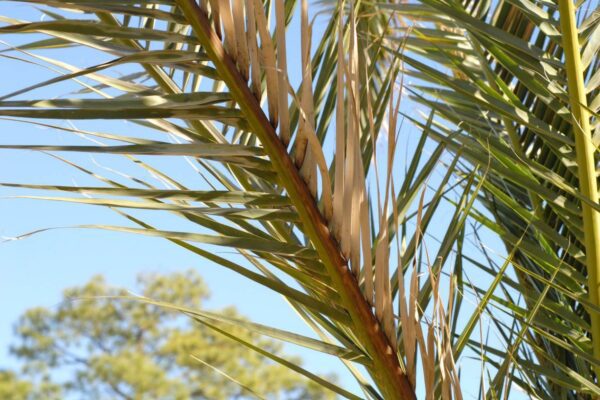
One-sided dead frond as a result of Fusarium wilt. ←
Canary Island date palm killed by Fusarium wilt. →
Photo credit: LSU
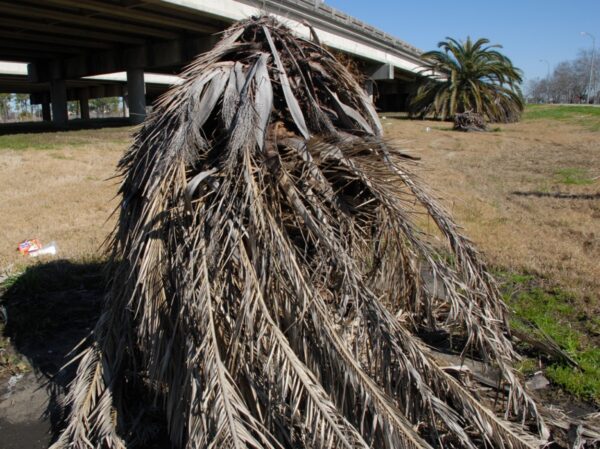
The bad news about Fusarium, as confirmed by the University of California’s Division of Agriculture and Natural Resources, is that it’s nearly always fatal and can kill a tree within one to two years of visible infection. What’s worse is that it spreads easily. If you prune a diseased palm with unsanitized tools and then use those same clippers on a healthy one, you’re essentially inoculating the next tree with the disease. It’s a silent killer, and it’s why prevention is so critical.
2.
South American Palm Weevil
The Silent Destroyer
If Fusarium is a slow, agonizing drain, the South American Palm Weevil (SAPW) is a shockingly fast, brutal attack. This invasive pest, Rhynchophorus palmarum, first detected in California in 2011, has rapidly become a well-established and devastating threat, particularly in our coastal and warm inland areas.
The adult beetles are pretty big, about 1.5 to 2 inches long, and black. They’re strong flyers and can travel a good distance to find a new host. They lay their eggs right inside the crown of the palm, the very heart of the palm. Once those eggs hatch, the larvae, which are grub-like and quite large, start tunneling down into the core of the palm. The palm’s heart ends up with extensive damage, from which there is no turning back.
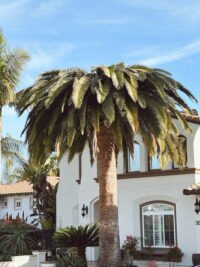
San Diego Canary Island date palm showing late signs of a South American palm weevil infestation. Notice the flat crown/canopy. This is sign that the palm is already dead and beyond saving.
By the time you notice something is wrong, the damage is often far too advanced to save the palm. We have seen it happen seemingly overnight. One day, a palm appears fine. Then the next time you glance at the palm, its crown is suddenly yellow and collapsed. You might see sticky sap oozing from holes near the top of the trunk, or even spot the beetles themselves flying around or crawling in the damaged areas.
UC Riverside’s Center for Invasive Species Research reported that by 2020, over 10,000 palms had been lost to SAPW in San Diego County alone. This pest is a major reason why palms across places like Coronado, Encinitas, and downtown San Diego have simply disappeared.
3.
Improper Care
The Unintentional Threat
Even without nasty pests or incurable diseases, Canary Island date palms are surprisingly vulnerable to damage caused by poor maintenance. These trees are actually quite low-maintenance and do not need a lot of trimming. But, ironically, they often get too much attention, especially from landscapers who aren’t familiar with their unique structure. This is why hiring an educated Certified Arborist is important in preserving the life of your Canary Island.
Common mistakes include:
- Removing healthy green fronds: This is probably the biggest mistake. These palms are giants, so they need a lot of energy. Those green fronds, even the lower ones, are like solar panels for the palm. They are vital for photosynthesis, creating the energy the palm needs to thrive, grow, and fight off disease. When you strip away too many, often aiming for that “pineapple” look, you’re essentially starving the tree and making it incredibly vulnerable. It’s like sending someone into a storm without a coat.
- Cutting too close to the trunk or damaging the crown: Every cut is a wound. If cuts are made too close to the trunk, or if the delicate crown, where new growth emerges, is damaged, it opens the door for infections like Fusarium or creates entry points for pests.
- Using unclean tools that spread disease: This goes back to Fusarium wilt. If a landscaper prunes a diseased palm and then uses the same uncleaned clippers or saws on your healthy palm, they’re acting as a vector for disease. It’s a preventable problem, but one we see far too often.
The result of improper care is a stressed, weakened tree with fewer natural defenses. It makes it much easier for Fusarium or the South American Palm Weevil to take hold and do their damage.
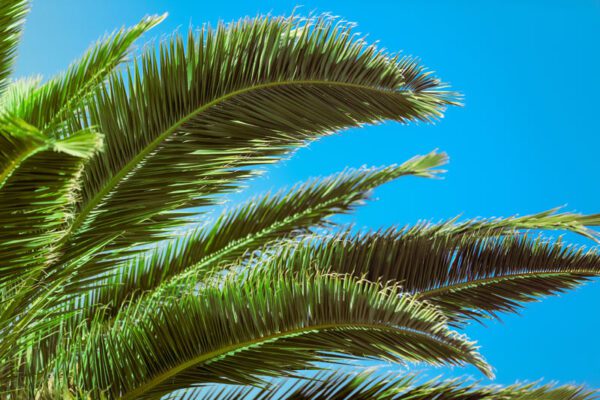
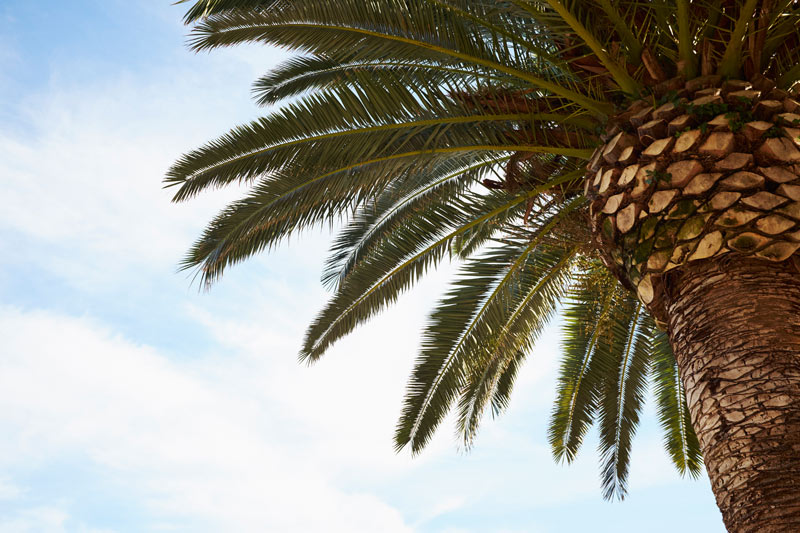
What can you do to protect your Canary Island date palm?
You don’t need to be an arborist to take good care of a palm. But you do need to know what to look for and when to act. A little proactive attention now can prevent a much bigger problem later.
- Inspect monthly. This is a big one. Take a few minutes to really look at your palm. Are the fronds turning yellow or drooping unevenly? Is the crown looking thinner than usual? Is it leaning? Because these issues can develop quickly, catching a small sign today could be a major problem next month. Early detection gives us a fighting chance.
- Sanitize your tools. If you do any pruning yourself, or if you hire someone, make sure the tools are clean. Think of it like washing your hands to prevent the spread of germs. A simple bleach solution (1 part bleach to 9 parts water) or rubbing alcohol can make a huge difference in preventing the spread of fungal diseases like Fusarium.
- Don’t over-prune. This is perhaps the most common mistake with Canary Island date palms. Remove only dead or damaged fronds. Green fronds are the tree’s food source, and stripping them away weakens the palm immensely, making it more susceptible to everything else. While other palms, like the Mexican fan palm, do well with heavy trimmings, with the Canary Island date palm, less is definitely more.
- Watch for beetles. Keep watch over the top third of the tree. The South American Palm Weevil is active, and if you see large black beetles or signs of sap or frass (sawdust-like material) near the crown, act immediately.
- Call a Certified Arborist. If anything looks off or if you are unsure, a professional can catch problems early. We have the training and experience to identify specific threats and recommend the right course of action.
When is it time to ask for help from a Certified Arborist?
Sometimes people wait too long, thinking a little yellowing is just part of the season, or that their palm just needs more water. But when it comes to these specific threats, especially the South American Palm Weevil or an advanced case of Fusarium, time is of the essence.
If you see sudden, rapid changes at the crown, significant leaning, sticky oozing sap, or visible beetles, do not wait. We have seen palms that could have been treated had we received a call one to two months earlier. But by the time the owner noticed the crown starting to tilt, the damage was irreversible. And removing a dying, unstable palm is always more complex and expensive than treating a sick one, not to mention the risk of the problem spreading to nearby trees.
At LC Tree Service, we have helped hundreds of property owners across San Diego with palms in distress. Sometimes it’s a quick diagnosis and a routine care plan to get the tree back on track. Other times, if the tree is too far gone, it’s a matter of safe removal and preventing the issue from spreading to nearby healthy palms. We understand how much these trees mean to our local landscape and to individual homeowners.
We offer free inspections and honest recommendations. We’ll never upsell you on work your tree doesn’t need, because for us, it’s not just about business, it’s about preserving a piece of what makes San Diego so special.
